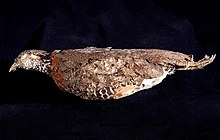| Chestnut-necklaced partridge | |
|---|---|

| |
| Specimen at Naturalis Biodiversity Center | |
| Conservation status | |
 Vulnerable (IUCN 3.1) | |
| Scientific classification | |
| Domain: | Eukaryota |
| Kingdom: | Animalia |
| Phylum: | Chordata |
| Class: | Aves |
| Order: | Galliformes |
| Family: | Phasianidae |
| Genus: | Tropicoperdix |
| Species: | T. charltonii |
| Binomial name | |
| Tropicoperdix charltonii (Eyton, 1845) | |
The chestnut-necklaced partridge (Tropicoperdix charltonii) is a species of bird in the family Phasianidae. It is found in forests in the Malay Peninsula and Sumatra. It is threatened by habitat loss and trapping. The International Union for Conservation of Nature (IUCN) has assessed it as vulnerable.
Taxonomy
This species was described by Thomas Campbell Eyton as Perdix Charltonii in 1845. The IOC World Bird List recognises the subspecies T. c. charltonii found in the Malay Peninsula, T. c. atjenensis in Sumatra. Some authorities have considered the green-legged partridge (A. chloropus) to be conspecific with this species. The Sabah partridge (T. graydoni) was also previously considered conspecific.
Description
The chestnut-necklaced partridge is 26–32 cm (10–13 in) long. The male weighs about 290 g (10 oz) and the female weighs about 250 g (8.8 oz). The crown and nape are brown, with dark speckles. The whitish supercilium, throat and neck have brown streaks. The upper breast is chestnut, with a blackish collar above it. The lower breast is brown, and the belly and flanks are buff. There are dark scales on the lower breast and flanks. The upperparts are brown, finely marked blackish and buff. The beak is greenish yellow, and the legs are yellow. The female bird is smaller and a little duller than the male. The subspecies atjenensis has brighter plumage, and graydoni has greenish-yellow legs.
Distribution and habitat
This partridge is found in the Thai-Malay Peninsula, Aceh, and South Sumatra. Its habitat is lowland evergreen forest and secondary forest.
Behaviour
This partridge probably forages in small groups, eating seeds, berries and termites. Its breeding has not been recorded. Its call is loud, steady couplets and triplets of whistles, and pairs often duet.
Status
The number of mature individuals is probably less than 10,000 and may be less than 2500. On Sumatra, the species has rarely been recorded recently. It is suspected to be declining because deforestation, logging and forest fires have destroyed much habitat and it is trapped and traded. The IUCN has assessed it as a vulnerable species. The IOC, IUCN and Clements considers T. c. graydoni, the Sabah partridge, a separate species and has assessed it to be near threatened.
References
- ^ BirdLife International (2016). "Tropicoperdix charltonii". IUCN Red List of Threatened Species. 2016: e.T22727395A94948018. doi:10.2305/IUCN.UK.2016-3.RLTS.T22727395A94948018.en. Retrieved 17 November 2021.
- Eyton, T. C. (1845). "Descriptions of some apparently new species of Birds from Malacca". The Annals and Magazine of Natural History. 16: 230.
- Gill, F.; Donsker, D. (eds.). "Pheasants, partridges & francolins". IOC World Bird List Version 7.3. Retrieved 5 December 2017.
- McGowan, P. J. K.; Boesman, P.; Christie, D. A.; Kirwan, G. M. "Chestnut-necklaced Partridge (Arborophila charltonii)". In del Hoyo, J.; Elliott, A.; Sargatal, J.; Christie, D. A.; de Juana, E. (eds.). Handbook of the Birds of the World Alive. Lynx Edicions.
- ^ Madge, Steve; McGowan, Phil (2010). Pheasants, Partridges & Grouse: Including buttonquails, sandgrouse and allies. Bloomsbury. pp. 267–268. ISBN 9781408135655.
- ^ Jeyarajasingam, Allen (2012). A Field Guide to the Birds of Peninsular Malaysia and Singapore. Oxford University Press. p. 75. ISBN 9780199639434.
- BirdLife International (2017). "Arborophila graydoni". IUCN Red List of Threatened Species. 2017: e.T22727389A118618068. doi:10.2305/IUCN.UK.2017-3.RLTS.T22727389A118618068.en.
Further reading
- Chen, D.; Liu, Y; Davison, G.W.H.; Dong, L.; Chang, J.; Gao, S.; Li, S.-H.; Zhang, Z. (2015). "Revival of the genus Tropicoperdix Blyth 1859 (Phasianidae, Aves) using multilocus sequence data". Zoological Journal of the Linnean Society. 175 (2): 429–438. doi:10.1111/zoj.12273.
- Chen, D.; Braun, E.L.; Forthman, M.; Kimball, R.T.; Zhang, Z. (2018). "A simple strategy for recovering ultraconserved elements, exons, and introns from low coverage shotgun sequencing of museum specimens: placement of the partridge genus Tropicoperdix within the Galliformes". Molecular Phylogenetics and Evolution. 129: 304–314. doi:10.1016/j.ympev.2018.09.005.
| Taxon identifiers | |
|---|---|
| Arborophila charltonii | |
| Perdix charltonii | |